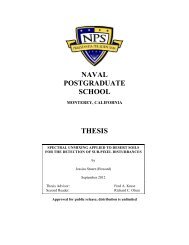October 2000 Newsletter - Naval Postgraduate School
October 2000 Newsletter - Naval Postgraduate School
October 2000 Newsletter - Naval Postgraduate School
You also want an ePaper? Increase the reach of your titles
YUMPU automatically turns print PDFs into web optimized ePapers that Google loves.
RESEARCH OVERVIEW<br />
MISSILE DEFENSE RESEARCH, continued from page 38<br />
Tracking and Killing Mobile Targets Using Precision<br />
Guided Munitions<br />
Associate Professor Russ Duren of the Department of Aeronautics<br />
and Astronautics and several thesis students are<br />
working on problems related to TBMD. CDR Randolph L.<br />
Mahr, USN, is investigating the application of precisionguided<br />
munitions against moving targets, such as mobile<br />
missile launchers. His thesis is tentatively titled, “Issues and<br />
Applications when Using GPS-guided Air-to-Ground Weapons<br />
Against Moving Targets.“ The goal of this thesis is to<br />
develop an executable model of a hypothetical sensor-toweapon<br />
real-time targeting system for the Joint Standoff<br />
Weapon. The model will be used to perform error and<br />
timing analyses to fully characterize the system’s performance.<br />
The tool chosen for the modeling task is Statemate Magnum<br />
from I-Logix, Inc. The tool should provide the capability of<br />
producing not just a simulation model, but an executable<br />
specification for the sensor-to-weapon system. This specification<br />
can serve as the template for a wide range of sensor-toweapon<br />
systems, allowing new systems to be quickly modeled<br />
and compared.<br />
LCDR Dean A. Wilson, USN, is investigating Multiple<br />
Source Integration/Data Fusion (MSI/DF) techniques that<br />
can be used on aircraft such as the E-2C Hawkeye. His thesis<br />
is tentatively titled, “Analysis of Multiple Source Integration<br />
(MSI) Techniques and Their Contributions to Probabilistic<br />
Combat Identification (CID).” Although the research is not<br />
specifically directed at identification and tracking of missiles,<br />
A two course sequence, Combat Systems Requirements and<br />
Design (SE2020) and Combat System Project Integration<br />
(SE4021), requires students to put to use their technical<br />
graduate education in a systems engineering solution to a<br />
current operational problem. The course sequence develops<br />
the requirements and investigates the conceptual systems<br />
design for combat systems of contemporary interest. The<br />
operational problem selected for detailed definition and<br />
solution is to be at the limits of today’s technology and<br />
operational arts. Examples include defense against tactical<br />
ballistic missiles, zero-collateral-damage counter-battery<br />
combat systems, and shallow water anti-submarine and<br />
mine warfare autonomous systems. The general scope of<br />
the systems project is determined in the first quarter<br />
that is one of the applications of the techniques under<br />
investigation.<br />
Atmospheric Optical Turbulence<br />
Solar heating, pressure variations, temperature gradients and<br />
wind shear all interact to produce turbulent flow within the<br />
atmosphere. Small temperature and density fluctuations<br />
carried by the turbulent air produce subtle phase distortions<br />
in electromagnetic waves traveling through the atmosphere.<br />
At optical wavelengths these effects accumulate over long<br />
paths of several kilometers to the point where they seriously<br />
degrade our ability to focus laser energy onto a target or blur<br />
the image of a target of interest.<br />
For some systems such as the U.S. Airborne Laser Program,<br />
part of the Theater Ballistic Missile Defense effort, atmospheric<br />
optical turbulence is a primary limitation to the<br />
ability to destroy missiles at long ranges. Knowledge of severe<br />
detrimental events such as the jet stream is essential for<br />
effective operational deployment of aircraft in the threat area.<br />
Professor Donald Walters, Department of Physics, and<br />
Research Assistant Professor Douglas Miller, Department of<br />
Meteorology, with assistance from Associate Professor<br />
Wendell Nuss of the Department of Meteorology, have<br />
adapted the U.S. Navy COAMPS (Coupled Ocean Atmosphere<br />
Meteorological Prediction System Model) developed<br />
by NRL Monterey, and used by Fleet Numerical Oceanography<br />
and Meteorology Center (FNMOC), so that it can<br />
--continued on page 40<br />
COMBAT SYSTEMS CURRICULUM INTEGRATES STRATEGIC MISSILE DEFENSE<br />
through the examination and discussion of current fleet<br />
requirements and plausible application of leading edge<br />
technology to meet the requirement.<br />
Subsequent quarters involve seminars, guest lectures,<br />
laboratory visits, and discrete problems and subprojects<br />
integrated into the courses of the curriculum. The final<br />
SE4021 course integrates the results of the subsystem studies<br />
begun earlier into the design of a combat system aimed at<br />
solving the operational problem. The resulting solution<br />
addresses the threat and operational environment; the assignment<br />
of tasks to subsystems components; the performance of<br />
the system in terms of it’s coverage, fire power, reaction time,<br />
and response to countermeasures; and costs. The results are<br />
presented to an experienced external review group.<br />
NPS Research page 39<br />
<strong>October</strong> <strong>2000</strong>
















